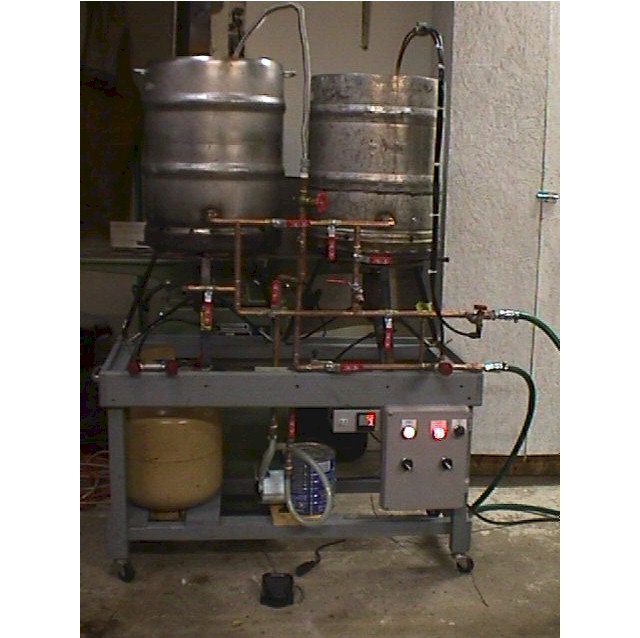 This is my RIM system. The unit is composed of two half barrel
Sankey kegs, two propane fired jet burners, copper plumbing and a Little Giant magnetic
drive pump.
This is my RIM system. The unit is composed of two half barrel
Sankey kegs, two propane fired jet burners, copper plumbing and a Little Giant magnetic
drive pump. Recirculating Infusion Mash Brewing System
 This is my RIM system. The unit is composed of two half barrel
Sankey kegs, two propane fired jet burners, copper plumbing and a Little Giant magnetic
drive pump.
This is my RIM system. The unit is composed of two half barrel
Sankey kegs, two propane fired jet burners, copper plumbing and a Little Giant magnetic
drive pump.
 The Mash/Lauter tun utilizes a
homemade false bottom and sparge head. The false bottom is a K-mart pizza pan with
hundreds of pre-drilled 1/8 inch holes. I stole this idea from another RIMS site.(thanks)
The pan is made of aluminum and the holes are bigger than what is usually recommended but
it works very well. I have'nt tasted anything odd in my finished product from the aluminum
and I would recommend the pan to anyone who is considering such a system. I connected the
sparge head to a stainless steel flexible gas line so it can be adjusted to meet my
sparging needs. Two thermo-couples constantly monitor my mash and sparge temperatures
through the use of a digital thermo-controller.
The thermo-controller has a PID or Proportional, Intregal, Derivative function that is
commonly used by many electric brewing systems. My mash temps are adjusted with fire so I
don't use the PID feature. I plumbed the propane line through a couple of finely
adjustable valves so I'm able to adjust temps slowly and gently. I also insulate the Mash
tun with a wrapping of aluminized bubble wrap stuff I purchased at a home improvement
store and it works fine. (NOTE: if you use the bubble wrap near fire be sure to fold
the bottom edge nearest the flame in the up position. Or, it will catch on fire
and stink up the house) Once a target mash temp is obtained I can turn the fire off for
quite a while before my temps begin to fall.
The Mash/Lauter tun utilizes a
homemade false bottom and sparge head. The false bottom is a K-mart pizza pan with
hundreds of pre-drilled 1/8 inch holes. I stole this idea from another RIMS site.(thanks)
The pan is made of aluminum and the holes are bigger than what is usually recommended but
it works very well. I have'nt tasted anything odd in my finished product from the aluminum
and I would recommend the pan to anyone who is considering such a system. I connected the
sparge head to a stainless steel flexible gas line so it can be adjusted to meet my
sparging needs. Two thermo-couples constantly monitor my mash and sparge temperatures
through the use of a digital thermo-controller.
The thermo-controller has a PID or Proportional, Intregal, Derivative function that is
commonly used by many electric brewing systems. My mash temps are adjusted with fire so I
don't use the PID feature. I plumbed the propane line through a couple of finely
adjustable valves so I'm able to adjust temps slowly and gently. I also insulate the Mash
tun with a wrapping of aluminized bubble wrap stuff I purchased at a home improvement
store and it works fine. (NOTE: if you use the bubble wrap near fire be sure to fold
the bottom edge nearest the flame in the up position. Or, it will catch on fire
and stink up the house) Once a target mash temp is obtained I can turn the fire off for
quite a while before my temps begin to fall.
The two hose lines connected to the manifold (seen on the right of the unit) are my freshwater in and wastewater out lines. I cut the ends off of a garden hose, divided it into two, and clamped male quick connects on the open ends. I quick connect one hose to the manifold water "in" fitting and connect the other end to my utility sink faucet. I do the same with my water "out" hose. I tried to design my system to be as compact and brewing friendly as possible. All of the components can be quickly disassembled for storage. I also tried to keep the ease of cleaning in mind. I fill the tanks, heat the water, sterilize the system and flush it down the drain. I learned the importance of these issues after struggling with my first design. I also learned to stay away from plastic and vinyl components as much as possible. Heat and plastics are a bad combination. These lines are also integrated with the immersion wort chiller located in the boiler tank. Boiling wort can be cooled down to a pitchable temperature in about 20 minutes.